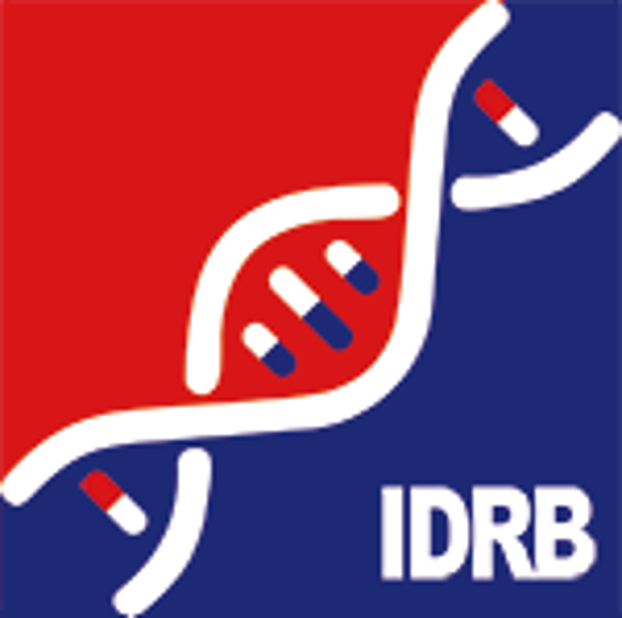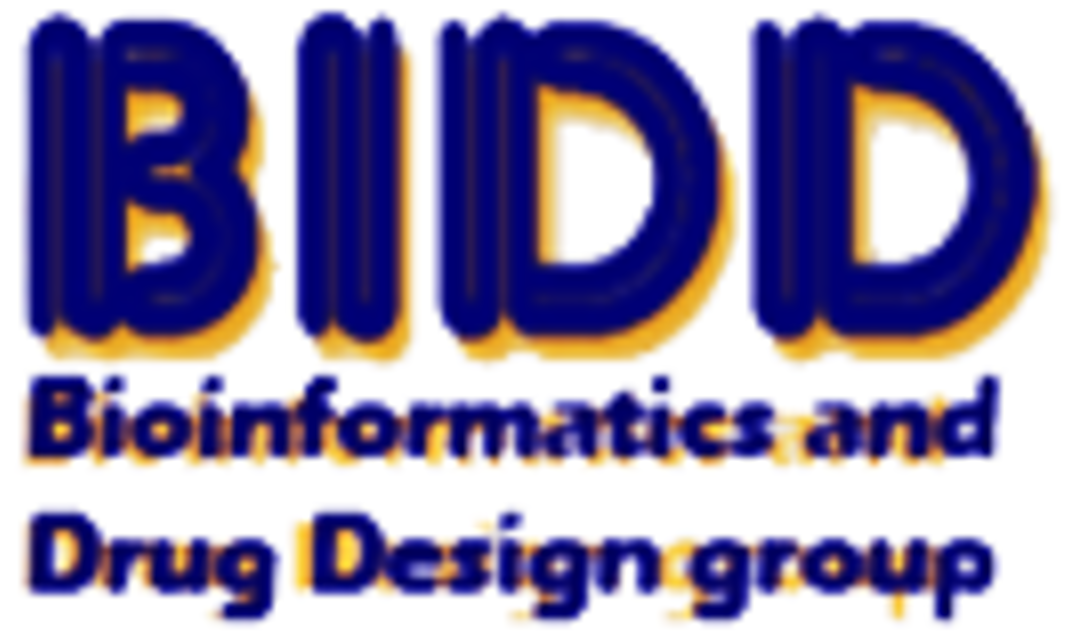Target Information
| Target General Information | Top | |||||
|---|---|---|---|---|---|---|
| Target ID |
T62276
(Former ID: TTDR01259)
|
|||||
| Target Name |
Glutamate receptor ionotropic NMDA 1 (NMDAR1)
|
|||||
| Synonyms |
NmethylDaspartate receptor subunit NR1; NMDR1; NMD-R1; N-methyl-D-aspartate receptor subunit NR1; Glutamate receptor ionotropic, NMDA 1; Glutamate [NMDA] receptor subunit zeta1; Glutamate [NMDA] receptor subunit zeta-1; GluN1
Click to Show/Hide
|
|||||
| Gene Name |
GRIN1
|
|||||
| Target Type |
Successful target
|
[1] | ||||
| Disease | [+] 2 Target-related Diseases | + | ||||
| 1 | Bacterial infection [ICD-11: 1A00-1C4Z] | |||||
| 2 | HIV-infected patients with tuberculosis [ICD-11: 1B10-1B14] | |||||
| Function |
Channel activation requires binding of the neurotransmitter glutamate to the epsilon subunit, glycine binding to the zeta subunit, plus membrane depolarization to eliminate channel inhibition by Mg(2+). Sensitivity to glutamate and channel kinetics depend on the subunit composition. Component of NMDA receptor complexes that function as heterotetrameric, ligand-gated ion channels with high calcium permeability and voltage-dependent sensitivity to magnesium.
Click to Show/Hide
|
|||||
| BioChemical Class |
Glutamate-gated ion channel
|
|||||
| UniProt ID | ||||||
| Sequence |
MSTMRLLTLALLFSCSVARAACDPKIVNIGAVLSTRKHEQMFREAVNQANKRHGSWKIQL
NATSVTHKPNAIQMALSVCEDLISSQVYAILVSHPPTPNDHFTPTPVSYTAGFYRIPVLG LTTRMSIYSDKSIHLSFLRTVPPYSHQSSVWFEMMRVYSWNHIILLVSDDHEGRAAQKRL ETLLEERESKAEKVLQFDPGTKNVTALLMEAKELEARVIILSASEDDAATVYRAAAMLNM TGSGYVWLVGEREISGNALRYAPDGILGLQLINGKNESAHISDAVGVVAQAVHELLEKEN ITDPPRGCVGNTNIWKTGPLFKRVLMSSKYADGVTGRVEFNEDGDRKFANYSIMNLQNRK LVQVGIYNGTHVIPNDRKIIWPGGETEKPRGYQMSTRLKIVTIHQEPFVYVKPTLSDGTC KEEFTVNGDPVKKVICTGPNDTSPGSPRHTVPQCCYGFCIDLLIKLARTMNFTYEVHLVA DGKFGTQERVNNSNKKEWNGMMGELLSGQADMIVAPLTINNERAQYIEFSKPFKYQGLTI LVKKEIPRSTLDSFMQPFQSTLWLLVGLSVHVVAVMLYLLDRFSPFGRFKVNSEEEEEDA LTLSSAMWFSWGVLLNSGIGEGAPRSFSARILGMVWAGFAMIIVASYTANLAAFLVLDRP EERITGINDPRLRNPSDKFIYATVKQSSVDIYFRRQVELSTMYRHMEKHNYESAAEAIQA VRDNKLHAFIWDSAVLEFEASQKCDLVTTGELFFRSGFGIGMRKDSPWKQNVSLSILKSH ENGFMEDLDKTWVRYQECDSRSNAPATLTFENMAGVFMLVAGGIVAGIFLIFIEIAYKRH KDARRKQMQLAFAAVNVWRKNLQDRKSGRAEPDPKKKATFRAITSTLASSFKRRRSSKDT STGGGRGALQNQKDTVLPRRAIEREEGQLQLCSRHRES Click to Show/Hide
|
|||||
| 3D Structure | Click to Show 3D Structure of This Target | PDB | ||||
| HIT2.0 ID | T86CQC | |||||
| Drugs and Modes of Action | Top | |||||
|---|---|---|---|---|---|---|
| Approved Drug(s) | [+] 1 Approved Drugs | + | ||||
| 1 | Cycloserine | Drug Info | Approved | Tuberculosis | [2], [3] | |
| Clinical Trial Drug(s) | [+] 2 Clinical Trial Drugs | + | ||||
| 1 | ELIPRODIL | Drug Info | Phase 2 | Multiple sclerosis | [4] | |
| 2 | NBQX | Drug Info | Phase 1 | Neurological disorder | [5] | |
| Discontinued Drug(s) | [+] 6 Discontinued Drugs | + | ||||
| 1 | YM-90K | Drug Info | Discontinued in Phase 2 | Convulsion | [6] | |
| 2 | DIZOCILPINE | Drug Info | Terminated | Cerebrovascular ischaemia | [7], [8] | |
| 3 | L-689560 | Drug Info | Terminated | Neurodegenerative disorder | [9], [10] | |
| 4 | L-698532 | Drug Info | Terminated | Neurological disorder | [11] | |
| 5 | L-698544 | Drug Info | Terminated | Alzheimer disease | [12] | |
| 6 | L-701324 | Drug Info | Terminated | Cerebrovascular ischaemia | [13], [14], [15] | |
| Mode of Action | [+] 3 Modes of Action | + | ||||
| Inhibitor | [+] 94 Inhibitor drugs | + | ||||
| 1 | Cycloserine | Drug Info | [1] | |||
| 2 | D-Serine | Drug Info | [16] | |||
| 3 | ELIPRODIL | Drug Info | [17] | |||
| 4 | NBQX | Drug Info | [18] | |||
| 5 | YM-90K | Drug Info | [19] | |||
| 6 | AM-92016 | Drug Info | [20] | |||
| 7 | DIZOCILPINE | Drug Info | [21] | |||
| 8 | L-687414 | Drug Info | [22] | |||
| 9 | L-695902 | Drug Info | [22] | |||
| 10 | L-698532 | Drug Info | [24] | |||
| 11 | L-698544 | Drug Info | [22] | |||
| 12 | L-701324 | Drug Info | [24] | |||
| 13 | MDL-105519 | Drug Info | [25] | |||
| 14 | RPR-104632 | Drug Info | [26] | |||
| 15 | SPERMINE | Drug Info | [27] | |||
| 16 | (D)-Ala-Pro-Glu | Drug Info | [28] | |||
| 17 | (R)-2-Amino-5-phosphono-pentanoic acid | Drug Info | [29] | |||
| 18 | (R)-2-Amino-7-phosphono-heptanoic acid | Drug Info | [29] | |||
| 19 | 1,3-ditolylguanidine | Drug Info | [30] | |||
| 20 | 2-(4-Phenoxy-benzyl)-1H-benzoimidazole | Drug Info | [31] | |||
| 21 | 2-(4-Phenoxy-benzyl)-3H-benzoimidazol-4-ol | Drug Info | [31] | |||
| 22 | 2-(4-Phenoxy-benzyl)-3H-benzoimidazol-5-ol | Drug Info | [31] | |||
| 23 | 2-(4-Phenoxy-benzyl)-3H-benzoimidazol-5-ylamine | Drug Info | [31] | |||
| 24 | 2-Methylamino-succinic acid(NMDA) | Drug Info | [23], [32] | |||
| 25 | 2-Pyridin-4-yl-1,2,3,4-tetrahydro-isoquinoline | Drug Info | [33] | |||
| 26 | 3-Benzoyl-7-chloro-4-hydroxy-1H-quinolin-2-one | Drug Info | [22] | |||
| 27 | 3-Carbamoyl-6-chloro-1H-indole-2-carboxylic acid | Drug Info | [34] | |||
| 28 | 3-Hydroxy-1H-benzo[b]azepine-2,5-dione | Drug Info | [35] | |||
| 29 | 3-Hydroxy-6-methyl-1H-benzo[b]azepine-2,5-dione | Drug Info | [35] | |||
| 30 | 3-Hydroxy-7-nitro-1H-benzo[b]azepine-2,5-dione | Drug Info | [35] | |||
| 31 | 3-Hydroxy-8-methyl-1H-benzo[b]azepine-2,5-dione | Drug Info | [35] | |||
| 32 | 3-phenyl-4-hydroxyquinolin-2(1H)-one | Drug Info | [24] | |||
| 33 | 4,5,7-Trichloro-3-hydroxy-1H-quinolin-2-one | Drug Info | [36] | |||
| 34 | 4,6-Dichloro-1H-indole-2-carboxylic acid | Drug Info | [37] | |||
| 35 | 4-(3,4-Dihydro-1H-isoquinolin-2-yl)-quinoline | Drug Info | [33] | |||
| 36 | 4-Benzyl-1-(2-phenoxy-ethyl)-piperidine | Drug Info | [17] | |||
| 37 | 4-Benzyl-1-phenethyl-piperidine hydrochloride | Drug Info | [38] | |||
| 38 | 4-Bromo-3-hydroxy-1H-quinolin-2-one | Drug Info | [36] | |||
| 39 | 4-Bromo-5,7-dichloro-3-hydroxy-1H-quinolin-2-one | Drug Info | [36] | |||
| 40 | 4-Chloro-3-hydroxy-1H-quinolin-2-one | Drug Info | [36] | |||
| 41 | 4-hydroxy-5-phenylthieno[2,3-b]pyridin-6(7H)-one | Drug Info | [24] | |||
| 42 | 4-[2-(3-Phenyl-propylamino)-ethyl]-phenol | Drug Info | [38] | |||
| 43 | 4-[2-(4-Benzyl-piperidin-1-yl)-ethoxy]-phenol | Drug Info | [17] | |||
| 44 | 4-[2-(4-Phenyl-butoxy)-ethyl]-phenol | Drug Info | [38] | |||
| 45 | 4-[2-(4-Phenyl-butylamino)-ethyl]-phenol | Drug Info | [38] | |||
| 46 | 4-[2-(4-Phenyl-piperidin-1-yl)-ethoxy]-phenol | Drug Info | [17] | |||
| 47 | 4-[2-(5-Phenyl-pentylamino)-ethyl]-phenol | Drug Info | [38] | |||
| 48 | 4-[2-(6-Phenyl-hexylamino)-ethyl]-phenol | Drug Info | [38] | |||
| 49 | 4-[3-(4-Phenyl-butylamino)-propyl]-phenol | Drug Info | [39] | |||
| 50 | 4-[3-(5-Phenyl-pentylamino)-propyl]-phenol | Drug Info | [38] | |||
| 51 | 4-{2-[Ethyl-(4-phenyl-butyl)-amino]-ethyl}-phenol | Drug Info | [38] | |||
| 52 | 5,6,7-Trichloro-1,4-dihydro-quinoxaline-2,3-dione | Drug Info | [40] | |||
| 53 | 5,7-Dibromo-1,4-dihydro-quinoxaline-2,3-dione | Drug Info | [40] | |||
| 54 | 5,7-Dichloro-1,4-dihydro-quinoxaline-2,3-dione | Drug Info | [40] | |||
| 55 | 5,7-Dichloro-3-hydroxy-1H-quinazoline-2,4-dione | Drug Info | [41] | |||
| 56 | 5,7-Dichloro-4-hydroxy-3-phenyl-1H-quinolin-2-one | Drug Info | [22] | |||
| 57 | 5,7-Dichlorokynurenic Acid | Drug Info | [42] | |||
| 58 | 5,7-Dinitro-1,4-dihydro-quinoxaline-2,3-dione | Drug Info | [22] | |||
| 59 | 6,7-Dichloro-1,4-dihydro-quinoxaline-2,3-dione | Drug Info | [40] | |||
| 60 | 6,7-Dichloro-3-hydroxy-1H-quinazoline-2,4-dione | Drug Info | [41] | |||
| 61 | 6-Chloro-1,4-dihydro-quinoxaline-2,3-dione | Drug Info | [43] | |||
| 62 | 6-Methoxy-2-(4-phenoxy-benzyl)-1H-benzoimidazole | Drug Info | [31] | |||
| 63 | 6-Nitro-1,4-dihydro-quinoxaline-2,3-dione | Drug Info | [43] | |||
| 64 | 6-Nitro-2-(4-phenoxy-benzyl)-1H-benzoimidazole | Drug Info | [31] | |||
| 65 | 7-chloro-3-hydroxyquinazoline-2,4-dione | Drug Info | [44] | |||
| 66 | 8-Bromo-3-hydroxy-1H-benzo[b]azepine-2,5-dione | Drug Info | [35] | |||
| 67 | 8-Chloro-3-hydroxy-1H-benzo[b]azepine-2,5-dione | Drug Info | [35] | |||
| 68 | 8-Ethyl-3-hydroxy-1H-benzo[b]azepine-2,5-dione | Drug Info | [35] | |||
| 69 | 8-Fluoro-3-hydroxy-1H-benzo[b]azepine-2,5-dione | Drug Info | [35] | |||
| 70 | Ala-Pro-Glu | Drug Info | [28] | |||
| 71 | AP-7 | Drug Info | [45] | |||
| 72 | Benzyl 4-aminobutyl(3-aminopropyl)carbamate | Drug Info | [46] | |||
| 73 | Cycloleucine | Drug Info | [47] | |||
| 74 | DNQX | Drug Info | [48] | |||
| 75 | Gly-Amp-Glu | Drug Info | [28] | |||
| 76 | Gly-b7Pro-Glu | Drug Info | [28] | |||
| 77 | Gly-Hyp-Glu | Drug Info | [28] | |||
| 78 | Gly-Pip-Glu | Drug Info | [28] | |||
| 79 | H-Gly-D-dmP-Glu-OH | Drug Info | [49] | |||
| 80 | H-Gly-dmP-Glu-OH | Drug Info | [49] | |||
| 81 | N,N'-Bis-(4-butoxy-phenyl)-guanidine | Drug Info | [30] | |||
| 82 | N,N'-Bis-(4-butyl-phenyl)-guanidine | Drug Info | [30] | |||
| 83 | N,N'-Bis-(4-ethyl-phenyl)-guanidine | Drug Info | [30] | |||
| 84 | N,N'-Bis-(4-hexyl-phenyl)-guanidine | Drug Info | [30] | |||
| 85 | N,N'-Bis-(4-isopropyl-phenyl)-guanidine | Drug Info | [30] | |||
| 86 | N,N'-Bis-(4-sec-butyl-phenyl)-guanidine | Drug Info | [30] | |||
| 87 | N-(2-methoxybenzyl)cinnamamidine | Drug Info | [50] | |||
| 88 | Nle-Pro-Glu | Drug Info | [28] | |||
| 89 | Phe-Pro-Glu | Drug Info | [28] | |||
| 90 | PHENCYCLIDINE | Drug Info | [51] | |||
| 91 | Phenethyl-(3-phenyl-propyl)-amine | Drug Info | [38] | |||
| 92 | Phenethyl-(4-phenyl-butyl)-amine | Drug Info | [38] | |||
| 93 | RPR-118723 | Drug Info | [26] | |||
| 94 | TRANSTORINE | Drug Info | [37] | |||
| Antagonist | [+] 7 Antagonist drugs | + | ||||
| 1 | L-689560 | Drug Info | [23] | |||
| 2 | CGP61594 | Drug Info | [23] | |||
| 3 | [3H]CGP39653 | Drug Info | [23] | |||
| 4 | [3H]CGS19755 | Drug Info | [23] | |||
| 5 | [3H]CPP | Drug Info | [23] | |||
| 6 | [3H]dizocilpine | Drug Info | [23] | |||
| 7 | [3H]MDL105519 | Drug Info | [23] | |||
| Agonist | [+] 5 Agonist drugs | + | ||||
| 1 | (+)-HA966 | Drug Info | [23] | |||
| 2 | (RS)-(tetrazol-5-yl)glycine | Drug Info | [23] | |||
| 3 | D-aspartic acid | Drug Info | [23] | |||
| 4 | homoquinolinic acid | Drug Info | [23] | |||
| 5 | L-aspartic acid | Drug Info | [23] | |||
| Cell-based Target Expression Variations | Top | |||||
|---|---|---|---|---|---|---|
| Cell-based Target Expression Variations | ||||||
| Drug Binding Sites of Target | Top | |||||
|---|---|---|---|---|---|---|
| Ligand Name: Esketamine | Ligand Info | |||||
| Structure Description | Structure of the human GluN1-GluN2B NMDA receptor in complex with S-ketamine,glycine and glutamate | PDB:7EU8 | ||||
| Method | Electron microscopy | Resolution | 4.07 Å | Mutation | No | [52] |
| PDB Sequence |
NIGAVLSTRK
37 HEQMFREAVN47 QANKRIQLNA62 TSVTHKPNAI72 QMALSVCEDL82 ISSQVYAILV 92 SHPPTPNDHF102 TPTPVSYTAG112 FYRIPVLGLT122 TRMSIYSDKS132 IHLSFLRTVP 142 PYSHQSSVWF152 EMMRVYSWNH162 IILLVSDDHE172 GRAAQKRLET182 LLEESKAEKV 194 LQFDPGTKNV204 TALLMEAKEL214 EARVIILSAS224 EDDAATVYRA234 AAMLNMTGSG 244 YVWLVGEREI254 SGNALRYAPD264 GILGLQLING274 KNESAHISDA284 VGVVAQAVHE 294 LLEKENITDP304 PRGCVGNTNI314 WKTGPLFKRV324 LMSSKYADGV334 TGRVEFNEDG 344 DRKFANYSIM354 NLQNRKLVQV364 GIYNGTHVIP374 NDRKIIWPGG384 ETEKPRGYQM 394 STRLKIVTIH404 QEPFVYVKPT414 LSDGTCKEEF424 TVNGDPVKKV434 ICTGPNDTSP 444 GSPRHTVPQC454 CYGFCIDLLI464 KLARTMNFTY474 EVHLVADGKF484 GTQERKEWNG 500 MMGELLSGQA510 DMIVAPLTIN520 NERAQYIEFS530 KPFKYQGLTI540 LVKKEDSFMQ 556 PFQSTLWLLV566 GLSVHVVAVM576 LYLLDRLSSA606 MWFSWGVLLN616 SGSFSARILG 633 MVWAGFAMII643 VASYTANLAA653 FLVLDRPEER663 ITGINDPRLR673 NPSDKFIYAT 683 VKQSSVDIYF693 RRQVELSTMY703 RHMEKHNYES713 AAEAIQAVRD723 NKLHAFIWDS 733 AVLEFEASQK743 CDLVTTGELF753 FRSGFGIGMR763 KDSPWKQNVS773 LSILKSHENG 783 FMEDLDKTWV793 RYQECDTLTF810 ENMAGVFMLV820 AGGIVAGIFL830 IFIEIAYKRH 840 K
|
|||||
|
|
||||||
| Ligand Name: [(1S)-1-{[(7-bromo-2,3-dioxo-1,2,3,4-tetrahydroquinoxalin-5-yl)methyl]amino}ethyl]phosphonic acid | Ligand Info | |||||
| Structure Description | Structure of the human GluN1/GluN2A NMDA receptor in the CGP-78608/glutamate bound state | PDB:7EOT | ||||
| Method | Electron microscopy | Resolution | 3.80 Å | Mutation | Yes | [53] |
| PDB Sequence |
KIVNIGAVLS
34 TRKHEQMFRE44 AVNQANKRHG54 SWKIQLNATS64 VTHKPNAIQM74 ALSVCEDLIS 84 SQVYAILVSH94 PPTPNDHFTP104 TPVSYTAGFY114 RIPVLGLTTR124 MSIYSDKSIH 134 LSFLRTVPPY144 SHQSSVWFEM154 MRVYSWNHII164 LLVSDDHEGR174 AAQKRLETLL 184 EERESKAEKV194 LQFDPGTKNV204 TALLMEAKEL214 EARVIILSAS224 EDDAATVYRA 234 AAMLNMTGSG244 YVWLVGEREI254 SGNALRYAPD264 GILGLQLING274 KNESAHISDA 284 VGVVAQAVHE294 LLEKENITDP304 PRGCVGNTNI314 WKTGPLFKRV324 LMSSKYADGV 334 TGRVEFNEDG344 DRKFANYSIM354 NLQNRKLVQV364 GIYNGTHVIP374 NDRKIIWPGG 384 ETEKPRGYQM394 STRLKIVTIH404 QEPFVYVKPT414 LSDGTCKEEF424 TVNGDPVKKV 434 ICTGPNDTSP444 GSPRHTVPQC454 CYGFCIDLLI464 KLARTMNFTY474 EVHLVADGKF 484 GTQERVNNSN494 KKEWNGMMGE504 LLSGQADMIV514 APLTINNERA524 QYIEFSKPFK 534 YQGLTILVKK544 EIPRSTLDSF554 MQPFQSTLWL564 LVGLSVHVVA574 VMLYLLDRFS 584 LTLSSAMWFS610 WGVLLNSGSF627 SARILGMVWA637 GFAMIIVASY647 TANLAAFLVL 657 DRPEERITGI667 NDPRLRNPSD677 KFIYATVKQS687 SVDIYFRRQV697 CLSTMYRHME 707 KHNYESAAEA717 IQAVRDNKLH727 AFIWDSAVLE737 FEASQKCDLV747 TTGELFFRSG 757 FGIGMRKDSP767 WKQNVSLSIL777 KSHENGFMED787 LDKTWVRYQE797 CTFENMAGVF 817 MLVAGGIVAG827 IFLIFIEIAY837 KRHKDAR
|
|||||
|
|
||||||
| Click to View More Binding Site Information of This Target with Different Ligands | ||||||
| Different Human System Profiles of Target | Top |
|---|---|
|
Human Similarity Proteins
of target is determined by comparing the sequence similarity of all human proteins with the target based on BLAST. The similarity proteins for a target are defined as the proteins with E-value < 0.005 and outside the protein families of the target.
A target that has fewer human similarity proteins outside its family is commonly regarded to possess a greater capacity to avoid undesired interactions and thus increase the possibility of finding successful drugs
(Brief Bioinform, 21: 649-662, 2020).
Human Tissue Distribution
of target is determined from a proteomics study that quantified more than 12,000 genes across 32 normal human tissues. Tissue Specificity (TS) score was used to define the enrichment of target across tissues.
The distribution of targets among different tissues or organs need to be taken into consideration when assessing the target druggability, as it is generally accepted that the wider the target distribution, the greater the concern over potential adverse effects
(Nat Rev Drug Discov, 20: 64-81, 2021).
Human Pathway Affiliation
of target is determined by the life-essential pathways provided on KEGG database. The target-affiliated pathways were defined based on the following two criteria (a) the pathways of the studied target should be life-essential for both healthy individuals and patients, and (b) the studied target should occupy an upstream position in the pathways and therefore had the ability to regulate biological function.
Targets involved in a fewer pathways have greater likelihood to be successfully developed, while those associated with more human pathways increase the chance of undesirable interferences with other human processes
(Pharmacol Rev, 58: 259-279, 2006).
Biological Network Descriptors
of target is determined based on a human protein-protein interactions (PPI) network consisting of 9,309 proteins and 52,713 PPIs, which were with a high confidence score of ≥ 0.95 collected from STRING database.
The network properties of targets based on protein-protein interactions (PPIs) have been widely adopted for the assessment of target’s druggability. Proteins with high node degree tend to have a high impact on network function through multiple interactions, while proteins with high betweenness centrality are regarded to be central for communication in interaction networks and regulate the flow of signaling information
(Front Pharmacol, 9, 1245, 2018;
Curr Opin Struct Biol. 44:134-142, 2017).
Human Similarity Proteins
Human Tissue Distribution
Human Pathway Affiliation
Biological Network Descriptors
|
|
|
There is no similarity protein (E value < 0.005) for this target
|
|
Note:
If a protein has TS (tissue specficity) scores at least in one tissue >= 2.5, this protein is called tissue-enriched (including tissue-enriched-but-not-specific and tissue-specific). In the plots, the vertical lines are at thresholds 2.5 and 4.
|
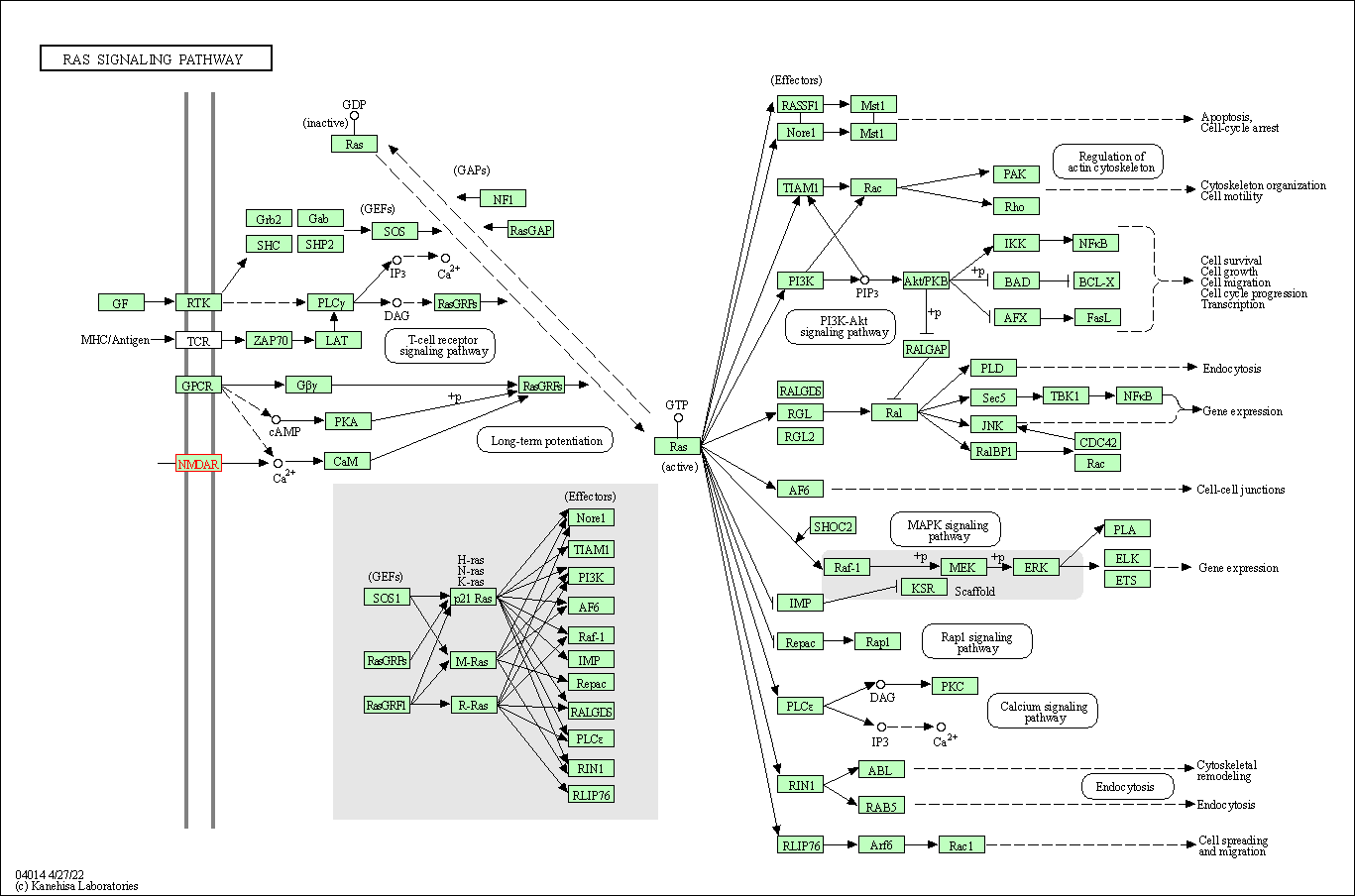
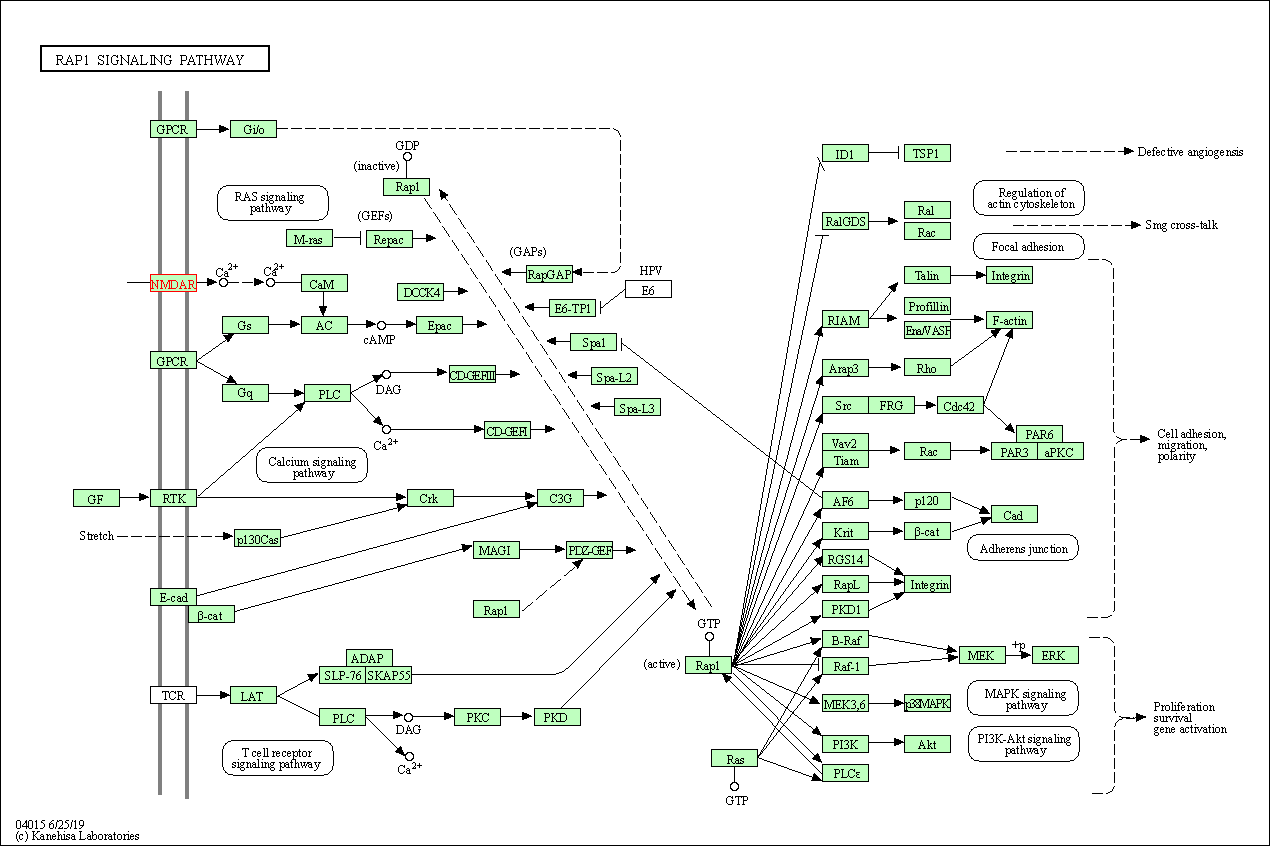

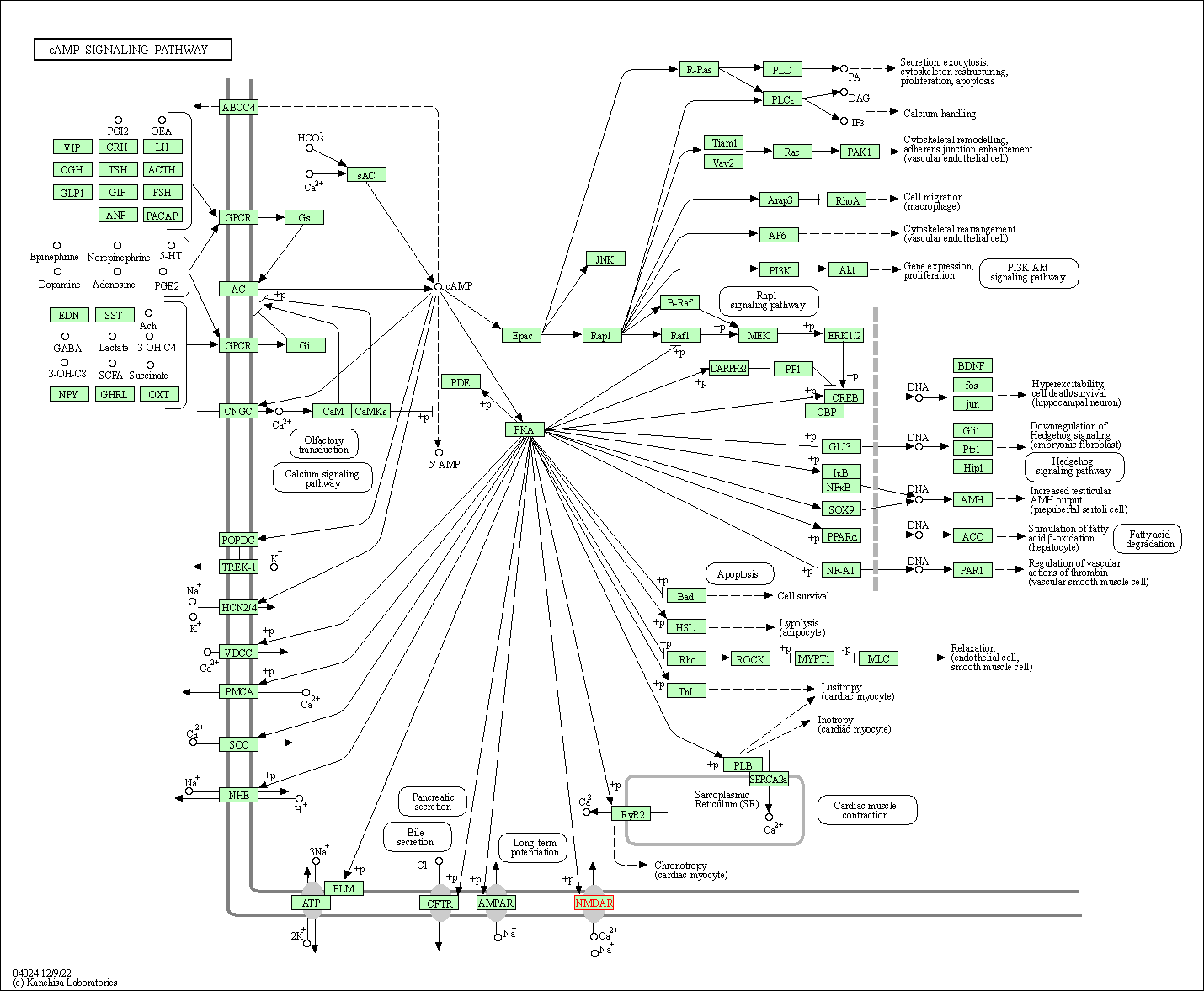
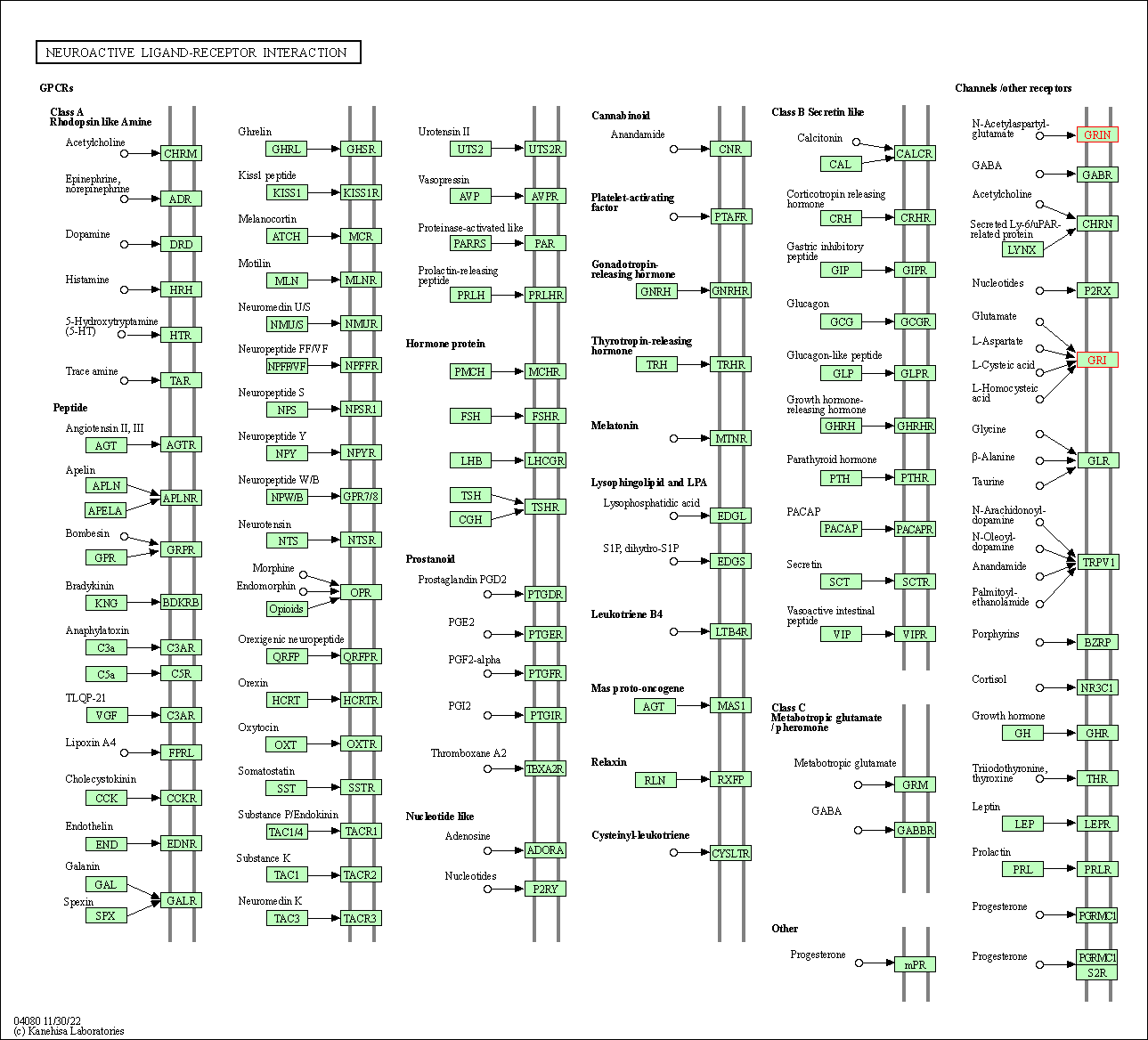
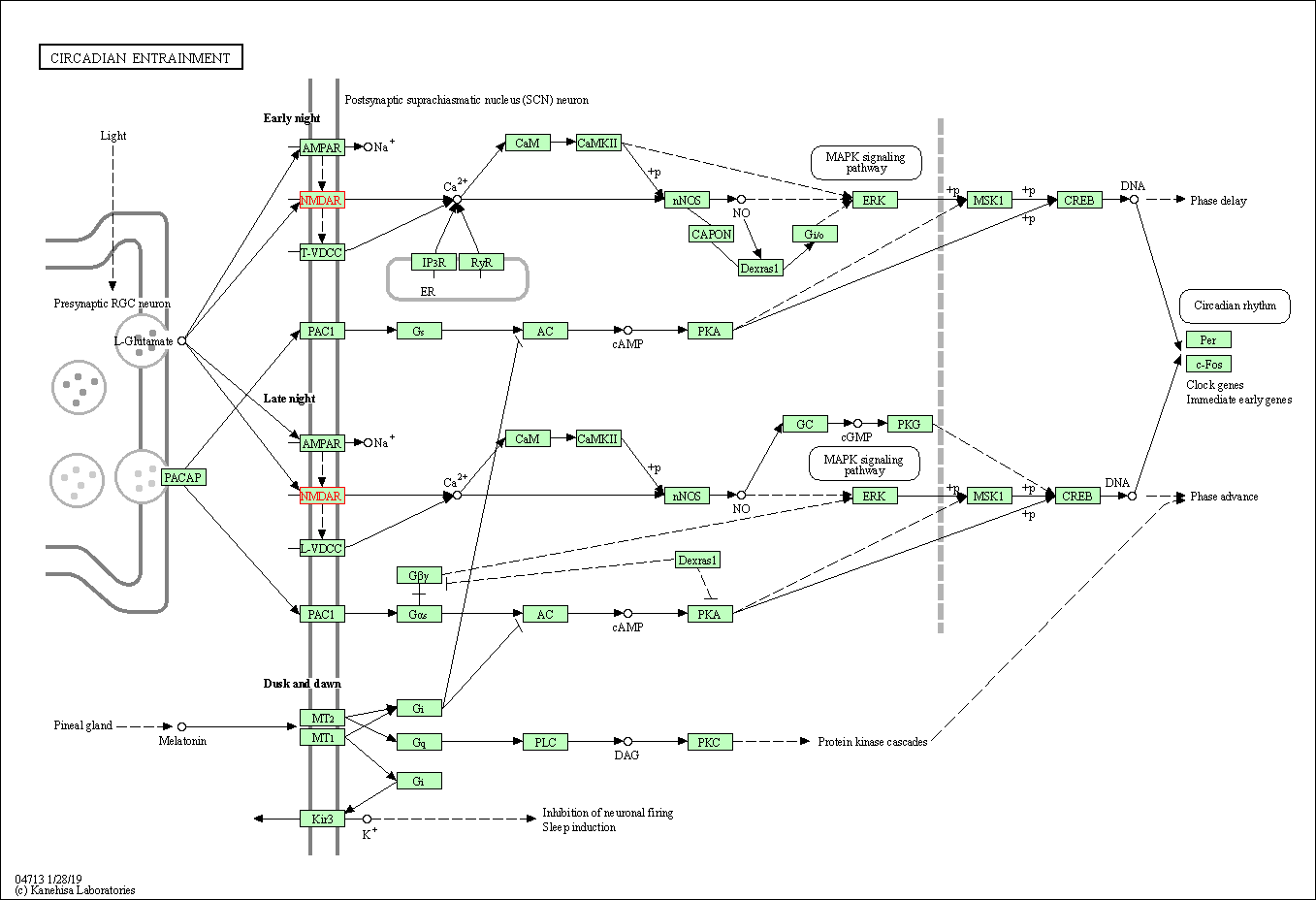


| KEGG Pathway | Pathway ID | Affiliated Target | Pathway Map |
|---|---|---|---|
| Ras signaling pathway | hsa04014 | Affiliated Target |

|
| Class: Environmental Information Processing => Signal transduction | Pathway Hierarchy | ||
| Rap1 signaling pathway | hsa04015 | Affiliated Target |

|
| Class: Environmental Information Processing => Signal transduction | Pathway Hierarchy | ||
| Calcium signaling pathway | hsa04020 | Affiliated Target |

|
| Class: Environmental Information Processing => Signal transduction | Pathway Hierarchy | ||
| cAMP signaling pathway | hsa04024 | Affiliated Target |

|
| Class: Environmental Information Processing => Signal transduction | Pathway Hierarchy | ||
| Neuroactive ligand-receptor interaction | hsa04080 | Affiliated Target |

|
| Class: Environmental Information Processing => Signaling molecules and interaction | Pathway Hierarchy | ||
| Circadian entrainment | hsa04713 | Affiliated Target |

|
| Class: Organismal Systems => Environmental adaptation | Pathway Hierarchy | ||
| Long-term potentiation | hsa04720 | Affiliated Target |

|
| Class: Organismal Systems => Nervous system | Pathway Hierarchy | ||
| Glutamatergic synapse | hsa04724 | Affiliated Target |

|
| Class: Organismal Systems => Nervous system | Pathway Hierarchy | ||
| Click to Show/Hide the Information of Affiliated Human Pathways | |||
| Degree | 9 | Degree centrality | 9.67E-04 | Betweenness centrality | 2.97E-05 |
|---|---|---|---|---|---|
| Closeness centrality | 2.08E-01 | Radiality | 1.36E+01 | Clustering coefficient | 3.61E-01 |
| Neighborhood connectivity | 1.82E+01 | Topological coefficient | 1.66E-01 | Eccentricity | 12 |
| Download | Click to Download the Full PPI Network of This Target | ||||
| Chemical Structure based Activity Landscape of Target | Top |
|---|---|
| Drug Property Profile of Target | Top | |
|---|---|---|
| (1) Molecular Weight (mw) based Drug Clustering | (2) Octanol/Water Partition Coefficient (xlogp) based Drug Clustering | |
|
|
||
| (3) Hydrogen Bond Donor Count (hbonddonor) based Drug Clustering | (4) Hydrogen Bond Acceptor Count (hbondacc) based Drug Clustering | |
|
|
||
| (5) Rotatable Bond Count (rotbonds) based Drug Clustering | (6) Topological Polar Surface Area (polararea) based Drug Clustering | |
|
|
||
| "RO5" indicates the cutoff set by lipinski's rule of five; "D123AB" colored in GREEN denotes the no violation of any cutoff in lipinski's rule of five; "D123AB" colored in PURPLE refers to the violation of only one cutoff in lipinski's rule of five; "D123AB" colored in BLACK represents the violation of more than one cutoffs in lipinski's rule of five | ||
| Co-Targets | Top | |||||
|---|---|---|---|---|---|---|
| Co-Targets | ||||||
| Target Poor or Non Binders | Top | |||||
|---|---|---|---|---|---|---|
| Target Poor or Non Binders | ||||||
| Target Profiles in Patients | Top | |||||
|---|---|---|---|---|---|---|
| Target Expression Profile (TEP) |
||||||
| Target-Related Models and Studies | Top | |||||
|---|---|---|---|---|---|---|
| Target Validation | ||||||
| References | Top | |||||
|---|---|---|---|---|---|---|
| REF 1 | How many drug targets are there Nat Rev Drug Discov. 2006 Dec;5(12):993-6. | |||||
| REF 2 | Novel agents in the management of Mycobacterium tuberculosis disease. Curr Med Chem. 2007;14(18):2000-8. | |||||
| REF 3 | Drugs@FDA. U.S. Food and Drug Administration. U.S. Department of Health & Human Services. 2015 | |||||
| REF 4 | ClinicalTrials.gov (NCT00001929) Treatment of Parkinson's Disease With Eliprodil. U.S. National Institutes of Health. | |||||
| REF 5 | URL: http://www.guidetopharmacology.org Nucleic Acids Res. 2015 Oct 12. pii: gkv1037. The IUPHAR/BPS Guide to PHARMACOLOGY in 2016: towards curated quantitative interactions between 1300 protein targets and 6000 ligands. (Ligand id: 4264). | |||||
| REF 6 | Trusted, scientifically sound profiles of drug programs, clinical trials, safety reports, and company deals, written by scientists. Springer. 2015. Adis Insight (drug id 800002155) | |||||
| REF 7 | URL: http://www.guidetopharmacology.org Nucleic Acids Res. 2015 Oct 12. pii: gkv1037. The IUPHAR/BPS Guide to PHARMACOLOGY in 2016: towards curated quantitative interactions between 1300 protein targets and 6000 ligands. (Ligand id: 2403). | |||||
| REF 8 | Trusted, scientifically sound profiles of drug programs, clinical trials, safety reports, and company deals, written by scientists. Springer. 2015. Adis Insight (drug id 800000713) | |||||
| REF 9 | URL: http://www.guidetopharmacology.org Nucleic Acids Res. 2015 Oct 12. pii: gkv1037. The IUPHAR/BPS Guide to PHARMACOLOGY in 2016: towards curated quantitative interactions between 1300 protein targets and 6000 ligands. (Ligand id: 4239). | |||||
| REF 10 | Trusted, scientifically sound profiles of drug programs, clinical trials, safety reports, and company deals, written by scientists. Springer. 2015. Adis Insight (drug id 800001828) | |||||
| REF 11 | Trusted, scientifically sound profiles of drug programs, clinical trials, safety reports, and company deals, written by scientists. Springer. 2015. Adis Insight (drug id 800006620) | |||||
| REF 12 | Trusted, scientifically sound profiles of drug programs, clinical trials, safety reports, and company deals, written by scientists. Springer. 2015. Adis Insight (drug id 800003218) | |||||
| REF 13 | URL: http://www.guidetopharmacology.org Nucleic Acids Res. 2015 Oct 12. pii: gkv1037. The IUPHAR/BPS Guide to PHARMACOLOGY in 2016: towards curated quantitative interactions between 1300 protein targets and 6000 ligands. (Ligand id: 4240). | |||||
| REF 14 | Anticonvulsant and behavioral profile of L-701,324, a potent, orally active antagonist at the glycine modulatory site on the N-methyl-D-aspartate receptor complex. J Pharmacol Exp Ther. 1996 Nov;279(2):492-501. | |||||
| REF 15 | L-701,324, a selective antagonist at the glycine site of the NMDA receptor, counteracts haloperidol-induced muscle rigidity in rats. Psychopharmacology (Berl). 1999 Apr;143(3):235-43. | |||||
| REF 16 | Therapeutic Target Database. Nucleic Acids Res. 2002 Jan 1;30(1):412-5. | |||||
| REF 17 | 4-Hydroxy-1-[2-(4-hydroxyphenoxy)ethyl]-4-(4-methylbenzyl)piperidine: a novel, potent, and selective NR1/2B NMDA receptor antagonist. J Med Chem. 1999 Jul 29;42(15):2993-3000. | |||||
| REF 18 | Synthesis, ionotropic glutamate receptor binding affinity, and structure-activity relationships of a new set of 4,5-dihydro-8-heteroaryl-4-oxo-1,2,... J Med Chem. 2001 Sep 13;44(19):3157-65. | |||||
| REF 19 | 4,10-Dihydro-4-oxo-4H-imidazo[1,2-a]indeno[1,2-e]pyrazin-2-carboxylic acid derivatives: highly potent and selective AMPA receptors antagonists with... Bioorg Med Chem Lett. 2000 May 15;10(10):1133-7. | |||||
| REF 20 | Enantiomeric propanolamines as selective N-methyl-D-aspartate 2B receptor antagonists. J Med Chem. 2008 Sep 25;51(18):5506-21. | |||||
| REF 21 | Synthesis and evaluation of 6,11-ethanohexahydrobenzo[b]quinolizidines: a new class of noncompetitive N-methyl-D-aspartate antagonists. J Med Chem. 1995 Jun 23;38(13):2483-9. | |||||
| REF 22 | Amino acid bioisosteres: design of 2-quinolone derivatives as glycine-site N-methyl-D-aspartate receptor antagonists, Bioorg. Med. Chem. Lett. 3(2):299-304 (1993). | |||||
| REF 23 | URL: http://www.guidetopharmacology.org Nucleic Acids Res. 2015 Oct 12. pii: gkv1037. The IUPHAR/BPS Guide to PHARMACOLOGY in 2016: towards curated quantitative interactions between 1300 protein targets and 6000 ligands. (Target id: 455). | |||||
| REF 24 | Synthesis of thieno[2,3-b]pyridinones acting as cytoprotectants and as inhibitors of [3H]glycine binding to the N-methyl-D-aspartate (NMDA) receptor. J Med Chem. 2006 Feb 9;49(3):864-71. | |||||
| REF 25 | CoMFA, synthesis, and pharmacological evaluation of (E)-3-(2-carboxy-2-arylvinyl)-4,6-dichloro-1H-indole-2-carboxylic acids: 3-[2-(3-aminophenyl)-2... J Med Chem. 2005 Feb 24;48(4):995-1018. | |||||
| REF 26 | Indeno[1,2-b]pyrazin-2,3-diones: a new class of antagonists at the glycine site of the NMDA receptor with potent in vivo activity. J Med Chem. 2000 Jun 15;43(12):2371-81. | |||||
| REF 27 | Bivalent beta-carbolines as potential multitarget anti-Alzheimer agents. J Med Chem. 2010 May 13;53(9):3611-7. | |||||
| REF 28 | New Gly-Pro-Glu (GPE) analogues: expedite solid-phase synthesis and biological activity. Bioorg Med Chem Lett. 2006 Mar 1;16(5):1392-6. | |||||
| REF 29 | Synthesis and pharmacology of N1-substituted piperazine-2,3-dicarboxylic acid derivatives acting as NMDA receptor antagonists. J Med Chem. 2005 Apr 7;48(7):2627-37. | |||||
| REF 30 | Synthesis and pharmacological evaluation of N,N'-diarylguanidines as potent sodium channel blockers and anticonvulsant agents. J Med Chem. 1998 Aug 13;41(17):3298-302. | |||||
| REF 31 | NR2B-selective N-methyl-D-aspartate antagonists: synthesis and evaluation of 5-substituted benzimidazoles. J Med Chem. 2004 Apr 8;47(8):2089-96. | |||||
| REF 32 | 2,4-Dihydro-3H-1,2,4-triazol-3-ones as anticonvulsant agents. J Med Chem. 1990 Oct;33(10):2772-7. | |||||
| REF 33 | 4-(3,4-dihydro-1H-isoquinolin-2yl)-pyridines and 4-(3,4-dihydro-1H-isoquinolin-2-yl)-quinolines as potent NR1/2B subtype selective NMDA receptor an... Bioorg Med Chem Lett. 2003 May 19;13(10):1759-62. | |||||
| REF 34 | 2-carboxy indolines and indoles as potential glycine/NMDA antagonists: effect of five-membered ring conformation on affinity. Bioorg. Med. Chem. Lett. 2(12):1627-1630 (1992). | |||||
| REF 35 | Analogs of 3-hydroxy-1H-1-benzazepine-2,5-dione: structure-activity relationship at N-methyl-D-aspartate receptor glycine sites. J Med Chem. 1996 Nov 8;39(23):4643-53. | |||||
| REF 36 | 3-Hydroxy-quinolin-2-ones: Inhibitors of [3H]-glycine binding to the site associated with the NMDA receptor, Bioorg. Med. Chem. Lett. 6(5):499-504 (1996). | |||||
| REF 37 | 3-(2-carboxyindol-3-yl)propionic acid derivatives: antagonists of the strychnine-insensitive glycine receptor associated with the N-methyl-D-aspart... J Med Chem. 1990 Nov;33(11):2944-6. | |||||
| REF 38 | Structure-activity relationships for a series of bis(phenylalkyl)amines: potent subtype-selective inhibitors of N-methyl-D-aspartate receptors. J Med Chem. 1998 Aug 27;41(18):3499-506. | |||||
| REF 39 | Structure-activity relationship for a series of 2-substituted 1,2,3,4-tetrahydro-9H-pyrido[3,4-b]indoles: potent subtype-selective inhibitors of N-... Bioorg Med Chem Lett. 1999 Jun 7;9(11):1619-24. | |||||
| REF 40 | 1-Hydroxy-1,4-dihydroquinoxaline-2,3-diones: Novel antagonists at NMDA receptor glycine sites, Bioorg. Med. Chem. Lett. 6(4):439-440 (1996). | |||||
| REF 41 | 3-hydroxy-quinazoline-2,4-dione as a useful scaffold to obtain selective Gly/NMDA and AMPA receptor antagonists. Bioorg Med Chem Lett. 2004 May 3;14(9):2345-9. | |||||
| REF 42 | The Protein Data Bank. Nucleic Acids Res. 2000 Jan 1;28(1):235-42. | |||||
| REF 43 | 5-(N-oxyaza)-7-substituted-1,4-dihydroquinoxaline-2,3-diones: novel, systemically active and broad spectrum antagonists for NMDA/glycine, AMPA, and... J Med Chem. 1997 Oct 24;40(22):3679-86. | |||||
| REF 44 | Structural investigation of the 7-chloro-3-hydroxy-1H-quinazoline-2,4-dione scaffold to obtain AMPA and kainate receptor selective antagonists. Syn... J Med Chem. 2006 Oct 5;49(20):6015-26. | |||||
| REF 45 | Bioisosteric replacement of the alpha-amino carboxylic acid functionality in 2-amino-5-phosphonopentanoic acid yields unique 3,4-diamino-3-cyclobut... J Med Chem. 1992 Dec 11;35(25):4720-6. | |||||
| REF 46 | Polyamines and the NMDA receptor: modifying intrinsic activities with aromatic substituents. Bioorg Med Chem Lett. 2006 Jun 1;16(11):2837-41. | |||||
| REF 47 | Effects of D-cycloserine and cycloleucine, ligands for the NMDA-associated strychnine-insensitive glycine site, on brain-stimulation reward and spontaneous locomotion. Pharmacol Biochem Behav. 1990 Aug;36(4):735-8. | |||||
| REF 48 | Kynurenic acid derivatives. Structure-activity relationships for excitatory amino acid antagonism and identification of potent and selective antago... J Med Chem. 1991 Apr;34(4):1243-52. | |||||
| REF 49 | The neuroprotective activity of GPE tripeptide analogues does not correlate with glutamate receptor binding affinity. Bioorg Med Chem Lett. 2006 Jul 1;16(13):3396-400. | |||||
| REF 50 | Indole-2-carboxamidines as novel NR2B selective NMDA receptor antagonists. Bioorg Med Chem Lett. 2005 Dec 15;15(24):5439-41. | |||||
| REF 51 | Synthesis and biological activity of conformationally restricted analogs of milnacipran: (1S,2R)-1-phenyl-2-[(S)-1-aminopropyl]-N,N-diethylcyclopro... J Med Chem. 1996 Nov 22;39(24):4844-52. | |||||
| REF 52 | Structural basis of ketamine action on human NMDA receptors. Nature. 2021 Aug;596(7871):301-305. | |||||
| REF 53 | Gating mechanism and a modulatory niche of human GluN1-GluN2A NMDA receptors. Neuron. 2021 Aug 4;109(15):2443-2456.e5. | |||||
If You Find Any Error in Data or Bug in Web Service, Please Kindly Report It to Dr. Zhou and Dr. Zhang.
